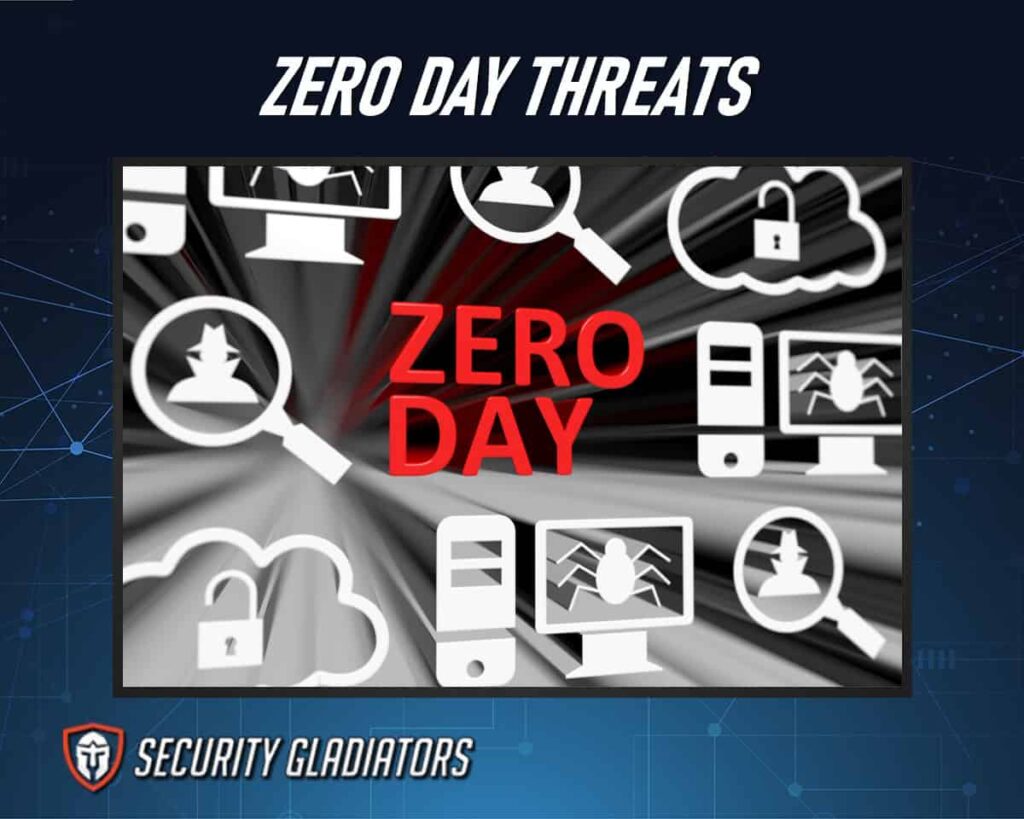As technology continues to evolve, cyber security is becoming an increasingly important concern for businesses and individuals alike. Zero-day threats are among the most serious of these concerns as they pose a significant risk to users in both the near-term and long-term future. This article will discuss what Zero Day threats are and how organizations can prepare against them in 2023 and beyond.
Zero day threats refer to vulnerabilities that have not been identified or patched by software developers before attackers exploit them. These attacks typically occur shortly after the vulnerability has been discovered, often within 24 hours of its discovery. In many cases, zero day threats are extremely difficult to detect until it is too late due to their fast-moving nature and lack of detection methods available at the time of attack.

Organizations must be prepared to combat zero day threats if they wish to remain secure in 2023 and beyond. By understanding exactly what these types of attacks entail, organizations can develop comprehensive plans and strategies to protect themselves from harm while also mitigating any damage that may already have occurred as a result of such an attack. With this knowledge, organizations can take proactive steps towards protecting themselves now so that they can continue operating securely into the future.
Table of Contents
What is a Zero-Day Threat?
A Zero-Day Threat is an attack on a computer system or network that takes advantage of previously unknown software vulnerabilities. It relies on the fact that these security flaws are not yet known and cannot be patched in order to gain unauthorized access to sensitive information. This type of threat is highly dangerous as it can remain undetected for long periods of time, potentially leaving organizations vulnerable to data theft or destruction. As such, organizations must take proactive measures in order to protect themselves from this type of attack.To properly understand what constitutes a zero day threat and its associated risks, it is important to consider why these attacks remain so difficult for many organizations to detect and prevent. One key factor contributing to their persistence is the sheer number of possible entry points into systems that may already have been infiltrated by malicious actors without being detected – making them even more difficult to protect against. Furthermore, with new technologies emerging at a rapid pace, there is always potential for the emergence of novel types of threats which could exploit unpatched vulnerabilities before they can be identified and addressed.
Organizations need effective strategies for detecting, preventing and mitigating zero-day threats if they are to stay ahead of attackers and reduce their risk exposure. Such strategies should include comprehensive vulnerability scanning regimes, rigorous patch management processes and continuous monitoring solutions designed specifically for identifying suspicious activity indicative of malicious behavior. Additionally, employing advanced detection methods such as machine learning algorithms can help identify anomalous activities indicating active exploitation attempts in real-time – enabling timely responses that limit the impact on operations while also allowing organizations greater insight into their own security posture going forward.
Types Of Zero-Day Threats
Zero-day threats have the potential to cause widespread damage to systems, networks and organizations. Understanding the different types of zero-day threats is essential in order to protect against them. In this section we will explore what a zero day threat is, how it can be detected, and some common examples of such attacks.
In order to better understand zero day threats and their associated risks, let’s look at some common types:
Web-Based Zero-Day Threats?
Web-based zero-day threats are malicious attacks that take advantage of previously unknown vulnerabilities in software and hardware. These threats can be particularly dangerous because they are often difficult to detect and prevent, as they rely on undiscovered or unpatched vulnerabilities. The term “zero-day” refers to the fact that these threats are discovered and exploited on the same day that the vulnerability is first discovered, giving attackers a window of opportunity to exploit the vulnerability before it can be addressed.
Network-Based Zero-Day Threats?
Network-based zero-day threats are malicious attacks that exploit security vulnerabilities that have yet to be identified or patched by software vendors. These threats can have a devastating impact on businesses and individuals alike, as they can be used to gain unauthorized access to systems, steal data, and spread malicious code.
Zero-day threats are particularly dangerous because they are hard to detect and protect against. They are not addressed by traditional security measures such as antivirus, firewalls, or intrusion prevention systems, which rely on signatures and known threats. The only way to protect against these threats is to update systems regularly with the latest security patches.
In addition to patching systems, organizations should also implement advanced security controls such as network segmentation, application whitelisting, and user access controls to reduce the attack surface and limit the spread of these zero-day threats. Organizations should also invest in security awareness training to help employees recognize suspicious activity.
Note:
Ultimately, zero-day threats can only be prevented with a comprehensive security strategy that combines both preventive and detective measures. Organizations must take the necessary steps to ensure their systems are protected from these evolving threats.File-Based Zero-Day Threats
File-based zero-day threats are malicious software that exploits previously unknown vulnerabilities to attack a computer system. These threats are difficult to detect and prevent because the security community has not yet had the opportunity to create a patch for the vulnerability before the threat is initiated. As the name suggests, this type of attack is typically initiated through a malicious file that is downloaded from an untrusted source. These files can be in the form of an executable (EXE), a document (DOC), a compressed file (ZIP), or any other type of file that can contain malicious code.
Once the malicious file is opened on the victim’s computer, it can take control of the system and compromise the security of the system. It can then be used to inject malicious code, steal data, and even delete files. The most effective way to prevent a file-based zero-day attack is to ensure that all files are scanned for malicious content before they are opened. Additionally, it is important to ensure that all software and operating system updates are installed in a timely manner, as they often contain security patches that can help protect against these types of threats.
Hardware-Based Zero-Day Threats
Hardware-based zero-day threats are malicious attacks that exploit a vulnerability in a computer system or network that has not yet been identified or addressed by the manufacturer. These threats can be used to gain access to sensitive information, disrupt services, or damage or disable hardware. They can also be used to gain control of a system and steal data or launch other malicious activities.
Hardware-based zero-day threats are especially dangerous because they can go undetected by traditional security measures, such as antivirus software and firewalls. Because the vulnerability is unknown, traditional security measures are unable to detect and prevent the attack. This makes it particularly difficult to defend against these threats, as they can be used to bypass traditional security measures.
This is important:
The best way to protect against hardware-based zero-day threats is to keep systems and networks up-to-date with the latest security patches and updates. Regular monitoring of system logs and traffic can also help identify suspicious activity, allowing for prompt remediation. Additionally, businesses should also deploy advanced security measures, such as intrusion detection systems, to detect and respond to potential threats.The Exploit Lifecycle
The exploit lifecycle is the stages an attacker goes through to successfully launch a zero-day threat. It begins with research, where attackers analyze available information about potential targets and search for vulnerabilities in their systems. The next stage is weaponization, which involves preparing malicious code that can be used to exploit these weaknesses. Once the attack has been launched, it enters into the detection stage, when security teams attempt to identify and mitigate any threats before they cause damage.
Zero-day threat detection is crucial in order to prevent or limit the impact of such attacks. There are various methods of detecting zero-day threats including signature-based detection systems as well as behavior-based approaches such as machine learning algorithms. In addition, organizations should also invest in threat intelligence services that provide real-time analysis of cyber activity and alert users of potentially suspicious activities.
Blended threats take advantage of both insider threat knowledge and zero-day attack techniques in order to gain access to sensitive data or disrupt networks. For example, an insider could use stolen credentials along with malware payloads developed by external actors to penetrate a company’s defenses undetected. While there are similarities between these two types of attacks, the primary difference lies in how they target organizations: insiders typically have greater access than external adversaries who rely on exploiting software vulnerabilities. Organizations must therefore adopt measures that protect against both internal and external threats in order to remain secure from advanced persistent threats (APTs).
Common Attack Vectors
To ensure the safety of cyberspace from such threats, it is crucial to understand common attack vectors that malicious actors use.

These vectors include:
- Phishing emails – Emails sent with malicious intent that appear legitimate and can be used to steal sensitive information or implant malware on an unsuspecting user’s device.
- Malware – A type of software designed by hackers to disrupt computer operations or access sensitive data without authorization. These programs are often hidden in downloadable files.
- Compromised accounts – Accounts belonging to individuals or organizations that have been hacked into by attackers and then used to gain access to sensitive information or resources.
- Social engineering attacks – Manipulative techniques employed by attackers to deceive victims into revealing confidential information or executing commands that ultimately benefit the attacker’s agenda.
To stay ahead of these threats, cyber security experts must remain vigilant and employ active detection methods such as scanning for suspicious activity and monitoring networks for signs of intrusion attempts. Additionally, effective measures should be taken to reduce vulnerability through regular patching cycles, secure authentication protocols, and rigorous employee training. Taking all these steps will help protect against devastating zero day attacks in 2023 and beyond.
How To Detect A Potential Zero-Day Attack
Zero-day threats have become increasingly difficult to detect in cyberspace. As the sophistication of malicious actors continues to increase, so too do their abilities to develop and exploit zero day vulnerabilities. It is thus essential for organizations to remain vigilant and proactively monitor for potential threats. There are several methods that can be employed to identify a potential zero day attack before it can cause irreparable damage.

The first step in detecting a possible zero-day threat is identifying indicators of compromise (IoCs) that may signal an impending attack. This could include suspicious activity such as unusual network traffic or strange user behaviors. IT professionals should also regularly scan networks with malware scanners, keeping up-to-date on any new OSX releases or patches released by vendors which address known security flaws. Additionally, monitoring systems logs for unexpected changes – including those related to system access control lists – can help uncover malicious activities early on.
Organizations must also ensure that they have strong incident response plans in place should a breach occur due to a zero-day vulnerability. These plans should outline procedures for mitigating the risks associated with the breach, assessing its scope and severity, performing forensic analysis, restoring compromised data, notifying stakeholders involved, and strengthening cyber defenses going forward. By being prepared ahead of time, businesses can more quickly respond to any intrusion attempts and reduce the likelihood of further damages caused by the attacker’s exploitation of the zero day flaw.
Zero-Day Mitigation Strategies
In the ever-evolving world of cyberspace, Zero Day threats are an increasing challenge. Therefore, it is essential to have effective strategies in place for mitigating such threats. The most important aspect of any mitigation strategy involves detection and prevention. Detection measures must be constantly monitored and updated as malicious activity changes over time. For instance, monitoring known vulnerabilities and instituting patch management protocols can help mitigate risk. Additionally, maintaining a strong cybersecurity presence through continuous security assessments and training staff on best practices will further reduce risk.
Note:
It is also essential to develop processes that identify anomalous behavior across networks, systems or applications quickly. Such techniques include implementing anomaly-based intrusion detection systems (IDS) with machine learning capabilities that detect suspicious activities by analyzing system behaviors in real time. Finally, having robust backup procedures helps ensure data integrity and quick recovery if a breach does occur. This includes regular backups of all critical data stored offsite so it remains safe from potential hackers or ransomware attacks.Patching And Security Updates
The most effective way to combat cyber threats is through patching and security updates. Patching helps keep systems up-to-date with the latest fixes, patches and upgrades which can help protect against zero day threats. Security updates are critical for protecting networks from malicious attacks. They provide a layer of protection by allowing users to detect any suspicious activity or unauthorized access in cyberspace.
Organizations must ensure their IT infrastructure remains secure by implementing necessary measures such as patching regularly and deploying security updates at regular intervals. Here are three key points organizations should consider when it comes to patching and security updates:
- Install the latest software versions available so that any new vulnerabilities discovered in older versions can be addressed quickly.
- Have an automated system for alerting administrators about potential risks associated with unpatched systems.
- Implement strategies for reducing attack surface area, such as limiting unnecessary services running on servers.
These practices enable businesses to stay ahead of emerging threats in order to maintain a safe environment while also ensuring compliance with industry standards. Staying proactive with patch management efforts will not only lower risk but also reduce costs due to fewer incidents caused by zero day threats and other related security breaches. It is important that companies remain diligent in implementing consistent methods of mitigating these types of threats on all levels within their networked environments in order to succeed in the ever-evolving cybersecurity landscape.
Endpoint Protection Solutions
As the world of cyberspace continues to expand, so too does the need for robust security solutions. Endpoint protection is a critical component in any organization’s defense against zero day threats. By leveraging advanced technologies such as artificial intelligence, machine learning and behavioral analytics, organizations can detect malicious activity before it has time to cause significant damage or disruption. Additionally, endpoint protection solutions offer features that allow organizations to customize their defensive strategies based on specific needs, including vulnerability scans and patch management services.
In order to ensure maximum protection from emerging threats, an effective endpoint security solution must incorporate multiple layers of defense into its approach. The first layer should focus on preventing intrusions via malware scanning and web filtering capabilities. These tools are designed to identify known attacks and suspicious traffic heading toward the network perimeter while also providing visibility into what’s happening within the environment itself. Additional measures such as host-based intrusion prevention systems (HIPS) can be used to supplement these defenses by detecting malicious code execution attempts at the operating system level.
Finally, automated threat response capabilities provide another important layer of defense when an attack succeeds in bypassing other protections. By automatically detecting anomalous behavior and isolating affected machines from the rest of the network until they have been properly cleaned or secured, organizations can minimize potential disruptions caused by successful cyberattacks with minimal manual intervention required. With all these elements combined together, endpoint protection solutions form an essential part of any comprehensive cybersecurity strategy when facing today’s ever-evolving risk landscape.
Firewall Protection
The growing sophistication of cyber attacks and the emergence of zero day threats necessitate a robust approach to firewall protection. Firewalls are an important component in any organization’s security architecture, providing a necessary layer of defense against potential threats originating from cyberspace. To stay ahead of attackers, it is important to ensure that firewalls are updated with the latest threat detection capabilities.

Organizations should consider leveraging multiple layers of defense when deploying firewalls – including port-level filtering, application-level inspection and intrusion prevention systems (IPS). OSX-based architectures may require additional integration steps for deployment, but also provide more granular control over access rules. In addition, companies must be sure to regularly monitor their networks for malicious activity using advanced analytics tools and sophisticated packet capture solutions.
By taking proactive measures such as these, businesses can help protect themselves from emerging zero day threats and reduce risk within their network environment. Organizations should prioritize comprehensive firewall protection strategies to maximize their ability to ward off cybercriminals and other adversaries who increasingly threaten our digital world.
Behavioral Analysis & Intrusion Detection Systems
As cyber threats continue to evolve, organizations must stay ahead of the curve by identifying and responding to zero-day threats in cyberspace. Behavioral analysis and intrusion detection systems are two key tools used for this purpose.
Behavioral Analysis: This technique focuses on analyzing user behavior within a system or network environment to detect malicious activities that may indicate a security breach. By monitoring user actions such as file accesses, data manipulation, login attempts and other events, behavioral analysis can identify suspicious patterns that could signal an attack.
Intrusion Detection Systems (IDS): An IDS is designed to detect abnormal activity on networks or computers that suggest unauthorized access or potential attacks. It typically works through signature-based matching or anomaly-based methods which look for deviations from established baselines of normal operations. Additionally, an IDS can be configured with rules related to known vulnerability signatures and various thresholds for alerting administrators about suspicious traffic.
Network Segmentation & Isolation Techniques
Network segmentation and isolation techniques are essential for protecting critical assets from malicious actors seeking access to sensitive information. By dividing networks into logical segments that are isolated from each other, organizations can limit the spread of a threat if one segment is compromised while maintaining the availability of essential services on other network segments.
Network segmentation requires careful planning and implementation as well as continuous monitoring and maintenance. A successful approach should include regular assessments of vulnerabilities within each network segment or subnet, along with active intrusion detection systems (IDS) configured to detect any unauthorized connections between them. It is also important to consider how data flows between different parts of the system, especially when it comes to sensitive resources such as personal data or financial records.
Finally, preventing an attacker from entering a cyberspace environment may require more advanced forms of isolation such as virtualization technology or sandboxes. Virtualization isolates applications from the underlying operating system by running them within their own secure environment. Sandboxing involves creating an isolated execution environment that limits code execution capabilities while allowing code analysis tools to inspect suspicious programs without risk of infection to other parts of the system. Both approaches can help reduce exposure to potential zero-day threats and enable faster detection and response times when they do occur.
User Education & Awareness Training
A fundamental step to addressing these threats is user education and awareness training. Such training should provide users with knowledge of how to recognize malicious activity, as well as help them understand their role in helping protect against cyber-attacks. Additionally, it can enhance user’s ability to detect suspicious behavior that could signal an attack before it happens.
This is important:
Organizations need to ensure that all employees are provided adequate instruction on basic cybersecurity practices, including password management, social engineering tactics, online safety protocols and proper use of anti-virus software. It is also critical for companies to update their security policies continuously and make sure they are being followed by everyone within the organization. Furthermore, organizations must invest in appropriate technology that can quickly detect any kind of malicious activities or unusual patterns across networks or systems.Finally, businesses must take active steps to create a culture of security among their staff members. Companies should encourage communication between team members related to possible risks associated with cyber threats which allows individuals themselves become proactive about identifying issues early on. This would enable teams to respond efficiently and effectively when faced with any type of cyber incidents going forward.
Incident Response Planning & Preparation
It is crucial for organizations to consider the potential impact of zero day threats and incorporate incident response planning and preparation into their security framework. Cybersecurity teams must develop a comprehensive understanding of the threat landscape, including both known and emerging risks that may arise in cyberspace. By having an organized plan in place to detect, analyze, respond to, contain, eradicate and recover from cyber incidents, organizations can mitigate the risk posed by such threats.
The importance of creating a robust incident response plan cannot be overstated. This should include strategies for identifying suspicious activities and indicators as well as provisions for reporting any detected breaches or evidence of malicious activity. To ensure sufficient protection against zero day attacks, it is important to regularly monitor network traffic and alert users if anything out of the ordinary is detected. Furthermore, staff should receive training on how to best prepare for potential cyber-attacks so they are better equipped to handle them if they occur.
Note:
Organizations need to remain vigilant when it comes protecting their digital assets from new types of threats and developing effective incident plans will go a long way towards helping them achieve this goal. It is essential that these plans cover all possible scenarios while also being flexible enough to adapt quickly in times of crisis. Regularly testing systems and processes will help identify gaps where additional measures could enhance overall security posture significantly.Emergency Response Procedures
In the face of increasingly sophisticated zero day threats, organizations must be prepared to implement effective emergency response procedures. Cybersecurity measures should include continuous threat detection and monitoring as well as a clearly articulated incident response plan that can be rapidly implemented in the event of an attack. To ensure digital safety and security for all users, here are three key points:
- Utilize operating systems such as OSX or Windows which offer built-in features designed to protect against vulnerabilities.
- Increase user awareness through education on cyber hygiene practices and proper password management.
- Develop an Incident Response Plan (IRP) with specific steps to take when responding to a breach or malicious activity detected in cyberspace.
Organizations need to stay ahead of emerging threats by implementing proactive strategies like patching software regularly, using multi-factor authentication protocols, and maintaining up-to-date antivirus solutions. Additionally, having adequate backup plans is essential; investing in secure cloud storage solutions will help minimize data loss and reduce recovery time following an attack. It’s also critical to document any suspicious activities so they can be investigated quickly if needed. By taking these precautionary steps now, businesses can mitigate potential risks while strengthening their cybersecurity posture for years to come.
Cyber Insurance Policies
The threat of zero-day threats in the cyberspace has grown exponentially over recent years, with no sign of slowing down. As such, it is essential for businesses and individuals alike to ensure that they are adequately protected from any malicious activity that may arise. Cyber insurance policies can be a valuable asset when combating these emerging threats, as they provide coverage if an organization experiences any financial loss due to cybercrime. Furthermore, these plans typically include measures for detecting new vulnerabilities before they become exploited by malicious actors.
In addition to providing financial protection against losses caused by cyber criminals, many cyber insurance policies also cover legal costs associated with defending claims made against organizations or individuals who have been affected by a security breach. This helps them protect their reputation and assets while protecting themselves from potential lawsuits should they become subject to litigation resulting from a data breach. Additionally, some providers offer services like crisis management consultants and IT experts that can help mitigate damages after an attack occurs.
Conclusion
The threat of zero-day attacks is an ever-present danger in the digital age. As technology continues to evolve, so too will the strategies and tactics of malicious actors looking to exploit vulnerabilities for financial gain or other motivations. It is therefore essential that organizations have a comprehensive plan in place to protect against these threats. This includes user education and awareness training, incident response planning and preparation, emergency response procedures, as well as cyber insurance policies. With proper planning and resources, organizations can reduce their risk from zero-day threats while still taking advantage of new technologies.

